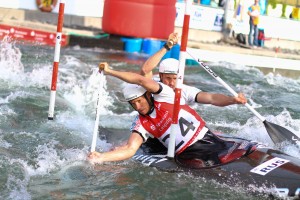Broadcast Solutions and the use of slomo.tv’s videoReferee on the road to Rio
 In this newly written case study, Broadcast Solution discusses its implementation of the slomo.tv videoReferee system in international Canoe Slalom competitions and its development to the point where it will be used as an overall video judging tool during the Canoe Slalom tournaments in Rio next month.
In this newly written case study, Broadcast Solution discusses its implementation of the slomo.tv videoReferee system in international Canoe Slalom competitions and its development to the point where it will be used as an overall video judging tool during the Canoe Slalom tournaments in Rio next month.
Canoe Slalom is one of the most dynamic and most spectacular boat sports. The aim is to complete – in a very short time – a white water course and to pass through gates downstream or upstream correctly. The gates should be passed completely without touching the rods. If this fails, the athlete will receive penalty seconds for touching the rods or missing the gate. Whether a rod is touched or a gate has been passed correctly can often be difficult to judge during competition.
In order to assist the referees on the course in questionable situations, the International Canoe Federation ICF has implemented video judging systems in international competitions since the year 2007. However, the common technical tools in use often reached their limits because of insufficient perspectives and available camera signals. Previously, the simultaneous viewing of several signals and perspectives was difficult to achieve and could hinder decision-making – yielding an unsatisfactory situation for athletes and fans alike.
videoReferee at the European championships
During the 2015 Canoe Slalom European Championships in Markkleeberg (Germany) ICF supported the local host with the implementation of video judging systems using a videoReferee system. With videoReferee the referees had access to up to 11 camera signals in HD quality. In the competition, all signals could be viewed and marked simultaneously during continuous recording. videoReferee offered the organisers and referees unprecedented opportunities to clarify controversial moments, thereby ensuring more fairness during the competition.
Jean Michel Prono, chairman Canoe Slalom, International Canoe Federation (ICF), remarked on using videoReferee during the competition: “videoReferee answers our need for a fast review of a situation while the race is still running. It really solves the problems we have with dubious situations.”
The videoReferee system used during the Canoe Slalom European Championships proved its flexibility in practical use. It was integrated easily into the existing infrastructure of the event and had access to two signal sources. On the one hand the system used the signals of the cameras already on-site. Additionally, videoReferee used video signals provided by the local host broadcaster.
The recording of all material with videoReferee provided a number of additional benefit, including new ways to use the recorded video material for marketing purposes.
A further step forward
The second use of videoReferee took place during the Canoe Slalom World Championships in London. For the first time videoReferee was used as the main judging system during a world championship. The event took place at Lee Valley White Water Centre near London. For this tournament a 12-channel videoReferee and a 11-channel backup system offered reliable and safe decisions during the tournament with 300 athletes from 55 countries participating and thousands of visitors on site and at home. During this second test the system was used as the main judging system, recording the signals of all cameras along the racetrack. Ultimately, this event demonstrated how videoReferee can speed up decisions, provide failsafe decisions, and reduce vetoes from athletes. Additionally, the recordings could be exported and were therefore used for training purposes.
Eric Lokken, ICF Canoe Slalom technical committee member, comments: “In the past, we had to rely on a produced video signal and had to request a replay, which caused a delay of the final result for each athlete. We used videoReferee for the first time during the world championships in London. The system was easy to learn, while setting up the software and finding out how to use it took only an afternoon.
“During the competition, you can easily choose by touchscreen which cameras you want to look at. In most cases, we could review a penalty during the run and deliver a solid result before the athlete crossed the finish line. Using this new tool during the Canoe Slalom World Championships made a huge impact [on the ability to deliver] the results in time [without a doubt].”
videoReferee on its way to Rio
Broadcast Solutions supported the tournament with two systems. The main system was a videoReferee MKIII with 12 channels recording simultaneously. A videoReferee MKII with up to 11 channels was used as a backup system. In 2016 videoReferee systems were in use during several Canoe Slalom World Cup tournaments around Europe, such as the European Canoe Slalom Championships in Liptovski (Slovenia), the World Cup Series in Ivrea (Italy), La Seu d’Urgell (Spain) or Pau (France), using some of the most famous white water courses in the world. During these competitions an exciting new discipline tested the system. In Canoe Slalom Cross three athletes start simultaneously by plunging into the water and have to pass four rods and achieve a roll. For next year’s Canoe Slalom Cross competitions, extensive testing and use of the videoRefeee system are scheduled.
More imminently, the videoReferee system will move on with the athletes to Rio, where it will be used as the main judging system for the Canoe Slalom tournaments.
